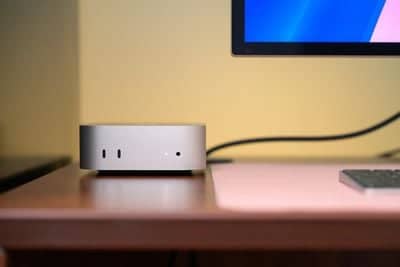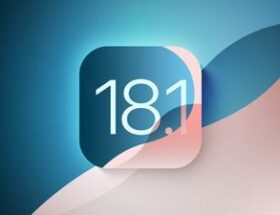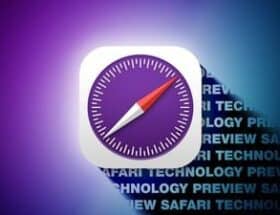Hartley Charlton
The new Mac mini goes on sale in stores and starts shipping to customers this Friday, with early reviews of Apple’s latest refresh appearing across select media outlets and YouTube channels.
 Image via The Verge
Image via The Verge
This year, the Mac mini gets its first redesign in more than a decade, introducing a significantly smaller chassis and two USB-C ports on the front of the chassis. Chris Welch of The Verge:
Every time I look at the new Mac mini on my desk, it feels like the perfect Mini shape. The redesigned enclosure makes the most of Apple Silicon’s small form factor, and with the Apple M4 chip and a wide selection of ports, the 2024 Mini should be a fast, reliable computer for years to come. It’s never been more powerful.
The M4 Pro version of the new Mac mini also supports Thunderbolt 5 connectivity, with three Type-C ports on the back. WIRED’s Brenda Stoilar on the new design and ports:
Many have compared the Mac mini’s new look to an Apple TV, but I think it looks more like a mini Mac Studio, especially with the new port layout. Apple has finally added ports to the front (something that bothered me on the M2-powered version), meaning I can spend less time annoyingly reaching around to the back to plug in a cable.
The M4 has two USB-C ports that support USB 3.0, and a 3.5mm headphone jack. Around the back are three Thunderbolt 4 ports (the M4 Pro variant gets three Thunderbolt 5 USB-C ports for the first time), plus HDMI, an Ethernet connection, and a power port. This marks the official end of the USB-A port on the Mac mini.
Reviewers also commented on the placement of the power button, which is now on the bottom of the device instead of the back. Stoilar added:
Front-panel ports are great. Moving the power button to the bottom? Not so much. It used to be on the back, but this new implementation is unintuitive. I have to lift the device and press the button to turn on my desktop. It's just weird. You'll probably leave this thing plugged in all the time, but like the USB-C port on the bottom of the Magic Mouse, it's just an awkward design choice.
The Verge's Chris Welch on the new Mac mini's power button move:
… Apple made the curious decision to move it to the bottom of the machine, near the back-left corner. Do I wish the button were somewhere else? Sure. Pressing it requires reaching across the Mini and lifting the device slightly. It’s silly, but it didn’t significantly impact my experience. If you have Apple’s Magic Keyboard with Touch ID, you’ll be reminded of its awkward location right during setup, when you have to double-click the power button to create a secure connection between the fingerprint sensor and your Mac. The Mini is used in a variety of environments, including home theaters and live production. I could imagine the button’s placement being an issue in some of those scenarios, but if you’re using it on a desk, it’s more of a quirk than an annoyance.
The new Mac mini is powered by Apple’s M4 and M4 Pro chips, which are up to 25% and 45% faster than their predecessors. At the time of writing, higher-end Mac mini configurations with the M4 Pro chip (14-core CPU) have a Geekbench multi-core score of 22,094 (the average of 11 results), compared to an average of 14,480 for the previous Mac mini with the highest-end M2 Pro chip. Engadget’s Devindra Hardawar on the Mac mini’s performance:
Outside the benchmarks, the Mac mini impressed me, running Lies of P at 1440p with graphics settings maxed out at 60 frames per second. It even managed to run the game at 4K with medium graphics settings, but the frame rate hovered around 30 fps, which wasn't very playable. But that's not a huge surprise — what's more important is that I know the GPU is powerful enough to run modern games at more reasonable resolutions. Resident Evil 4 and No Man's Sky also managed a solid 60 fps at 1440p.
To test the Mac mini’s AI capabilities, I used the Whisper Transcription app to transcribe an hour-and-nine-minute Engadget podcast episode. It took two minutes and nine seconds using a small language model. By comparison, the M4-powered 14-inch MacBook Pro took three minutes and three seconds, and the M3-powered 14-inch MacBook Pro took three minutes and thirty-seven seconds. These numbers tell us that Apple’s M4 hardware can help students quickly take notes from lecture recordings or even transcribe classes in real time without much effort.
The M4 series of chips also brings an updated GPU architecture with improved efficiency, hardware-accelerated ray tracing, AV1 decoding support, up to 64GB of LPDDR5X memory, dynamic caching, and a much more powerful Neural Engine to the Mac mini. Reviewers also praised the new Mac mini’s cooling design. Welch added:
Apple’s updated cooling system for the Mini helps the M4 run quietly. Even when I’m deep in a photo editing session in Lightroom, I can’t hear the fan. I’m sure the M4 Pro’s extra GPU cores will make those RAW edits even faster, but the regular M4 handles most photo editing tasks just fine. Otherwise, the machine rarely skipped a step, no matter what I threw at it. I’m not a videographer, so I can’t say whether serious editing work will push the M4 to its limits. If there’s one use case that justifies upgrading to the M4 Pro, it’s likely this one.
TechCrunch’s Brian Heather concluded that the new Mac mini is well designed, but without a clear target audience:
The new Mac mini is a case of a (mostly) well-designed machine without a completely clear market segment. Its best bet is for those who already have a monitor or monitors and just want to upgrade their system with the latest entry-level Mac. I’d classify this as someone who wants to pick out their own monitor but doesn’t want to invest in the Studio and doesn’t particularly care for the freedom that a laptop provides. Or maybe the Platonic ideal is someone who wants a fast, simple, and (relatively) cheap desktop to go with it – without the built-in limitations of an all-in-one iMac.
If any of the above rings true, then by all means, go for the small one. There’s little inherently wrong with this machine (the power button is more annoying than bad), but it’s not entirely clear where it fits in Apple’s desktop lineup, with the Studio and iMac on either side of it.
I can’t say for sure how big that market segment is at the moment, but I suspect this is the system most likely to be bought by the enterprise. It’s easy to imagine companies buying them up in bulk. Consumers who are still undecided should consider whether a MacBook or an iMac is better for their setup and budget.
Video
Play
Play
Play
Play
Related Review: Mac miniBuyer's Guide: Mac Mini (Buy Now)Related Forum: Mac mini121 comments









